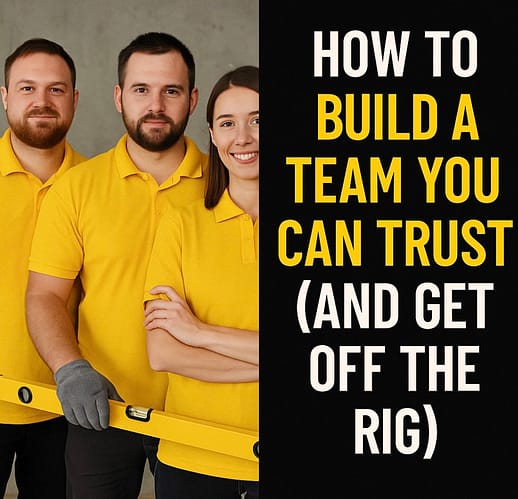How to Build a Team You Can Trust (And Get Off the Rig)
By: Josh Fulfer
Estimated Read Time: 7 Minutes
 I talk to a lot of concrete lifters. Most of them are hard-working, skilled, and serious about building something real.
I talk to a lot of concrete lifters. Most of them are hard-working, skilled, and serious about building something real.
But too many of them are still doing everything themselves.
Answering the phone. Running quotes. Pumping foam. Fixing rigs. Following up on leads. Tracking down invoices. Scheduling jobs. Chasing reviews.
Eventually, that catches up with you. You burn out. Or worse—you stall out. You can only grow so far when you’re the one doing all the lifting.
If you want to build a real business, you’ve got to build a real team.
Step 1: Shift Your Identity
This is the hardest part for most guys—not hiring. Not training. It’s letting go of being the only one who can do the job right.
Yes, no one will care as much as you do. That’s normal.
But your job isn’t to find clones—it’s to build systems and lead people well.
Great teams aren’t found. They’re built.
Step 2: Hire Character Over Experience
In this trade, you can teach the technical skills. But you can’t teach attitude, work ethic, or pride.
I’ve seen some of the best crews come from guys who had zero lifting experience—but were clean-cut, on time, respectful, and eager to learn.
✅ Look for guys who show up early
✅ Who ask questions
✅ Who have a good handshake and eye contact
✅ Who take pride in a job well done
You can’t teach integrity. But you can train the rest.
Step 3: Document Everything (Start with Your Phone)
The easiest way to start building a training system? Use your phone.
Next time you bid a job—film yourself explaining how you walk through the estimate.
Next time you set up your hoses—show where and why.
Turn your day-to-day into a repeatable system your team can learn from.
Upload those videos to a private YouTube playlist or Dropbox folder and call it “Training.” Doesn’t need to be fancy—just clear and consistent.
Step 4: Start Small, Then Step Back
Start by delegating a few key tasks:
✅ Let someone else prep the site
✅ Let someone else mix and clean
✅ Let someone else run the hoses while you direct the foam
Then slowly back off. Let them lead the lift while you watch.
Eventually, you can trust them to handle the job start to finish—because you trained them right.
Step 5: Build a Culture of Ownership
Guys who feel trusted, respected, and valued stick around.
So lead with clarity. Pay fairly. Give praise. Address problems fast. And keep the vibe sharp, not sloppy.
This isn’t just a job. It’s a team. A business. A brand.
Let them wear it with pride—and they’ll treat it with pride.
Step 6: Let Go (But Stay Plugged In)
Once you’ve got 1–2 solid crew members running jobs, you don’t disappear—but you don’t micromanage either.
You keep tabs. You train. You drop in and spot-check. You build confidence in your guys so they can lead the right way – without you being around all the time. But now you’re freed up to grow the business—build partnerships, run estimates, dial in marketing, and focus on the big picture.
Final Thoughts
You didn’t start this business to work yourself into the ground. You started it to create freedom—for your family, your future, and your life.
The only way to get there is with people.
Build the team. Train them well. Show them what great looks like. And then step into your real role: business owner, leader, builder of something that lasts.
And if you need help making your business look like a business online?
That’s what we do at LevelRight Marketing. We build websites and systems that help concrete lifters grow and get off the rig—for good.
Bonus: Don’t Forget Formal Training Options
While on-the-job training is key to teaching your crew how you do things, it can also help to send your team through a structured program.
Some concrete lifting manufacturers offer training events and courses that cover the basics of poly foam lifting, safety, commercial techniques, and more. These can be a great supplement to your in-house training—especially if you want a crew member to see the full picture of the industry.
We broke down the best programs in this article: The Best Concrete Lifting Training Companies in the U.S.
Use both: teach your systems, then expand their skillset with formal education when the time is right.







